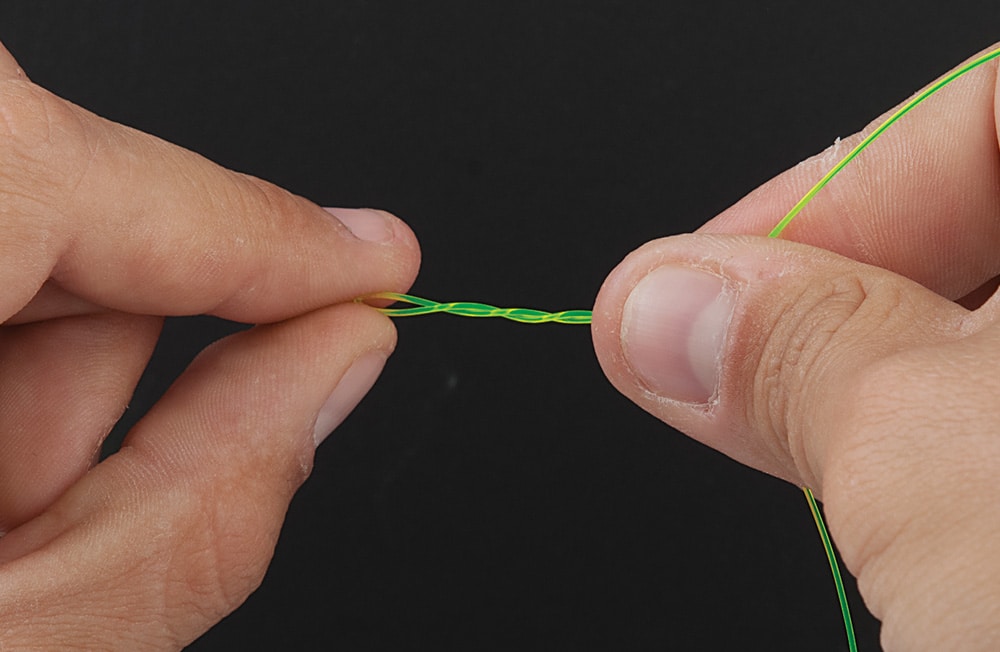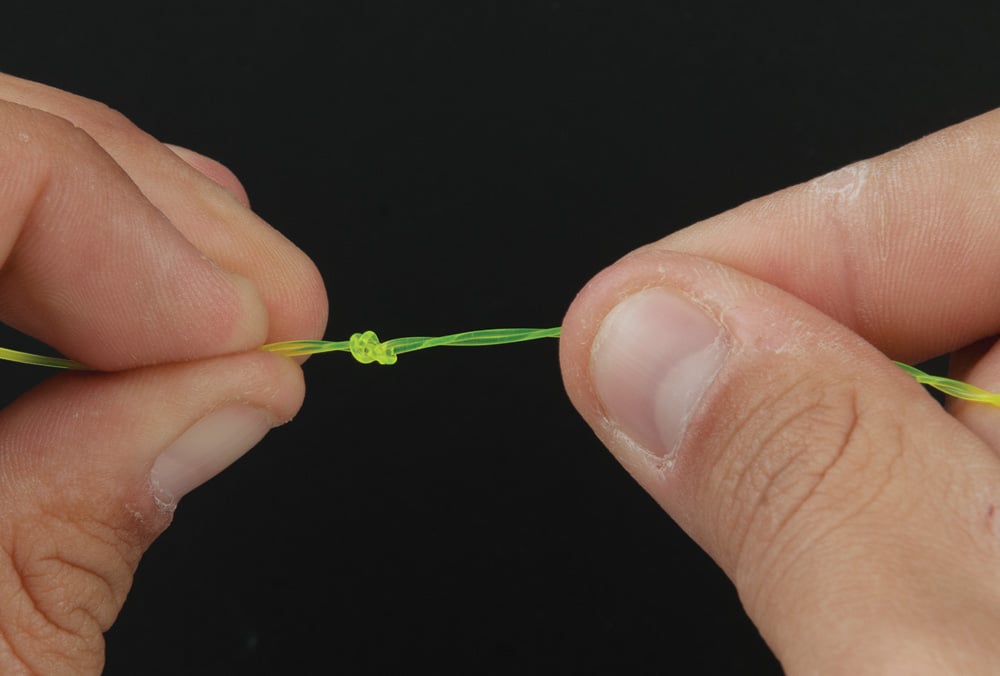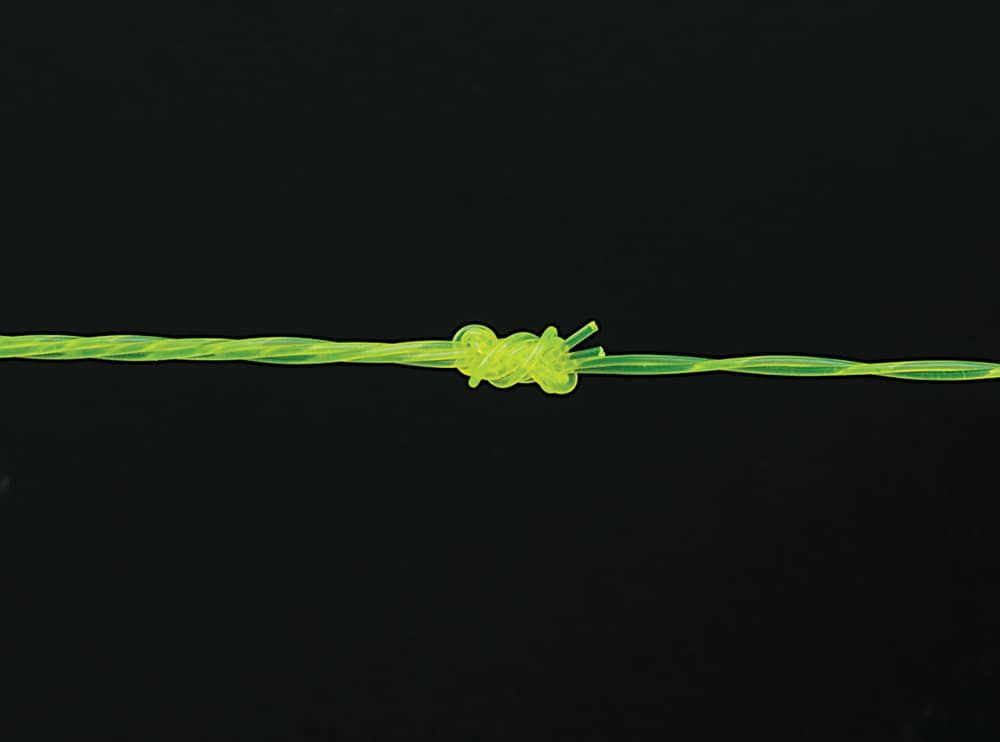Click through the images above to see step-by-step of two-section twisted leaders.
Anglers could literally spend days upon days scouring the Internet researching one fly-fishing technique after another. Leader systems may not be the most glamorous topic searched, but in tough fishing situations, you’d be hard-pressed to put a value on one that’s properly constructed.
If you wish to dig a little deeper and get more performance out of your leader, keep reading — with a little twist, you can say goodbye to flies that fall short in windy conditions. Though twisted leaders are little more than doubled-over sections of monofilament, they are very effective tools for many saltwater fishing situations. The butt end has a loop that attaches directly to the fly line, while the other end is looped or knotted directly to the tippet. They can be made quickly and easily in a two-section style while on the water, or purchased commercially in a more complex three-section style that will maximize the benefits of this leader system.
Advantages of Twisted Leaders
Without a doubt, the biggest advantage to this style of leader is turnover. Getting complete leader extension means a longer cast, which almost always ups your odds. Also, when your leader stretches to its full length, you have immediate tension on the fly on the first strip. With poor turnover as a result of wind or just the use of large, air-resistant flies, not only is distance lost at the end of the cast, but it is also harder to predict exactly where the fly will land. When this happens, it often takes four or five strips before the slack is gone and the fly starts moving, which obviously makes for less-efficient fishing. When using large streamers or top-water flies, a twisted leader will out-fish a standard, single-strand tapered leader day in and day out.

_Some anglers prefer to attach a swivel to the end of their twisted leaders in lieu of using a loop-to-loop connection. _
Another benefit of twisted leaders is their shock absorption. When targeting hard-pulling big-game species that can put serious heat on International Game Fish Association class tippets, having a leader that can absorb some of the stress put on the line by a violent strike or unexpected head shake can be the difference between landing the fish of a lifetime and crying at the sight of a broken knot. Because twisted leaders have far more stretch than single-strand line of the same material, they are great for protecting class tippets when doing battle with tarpon, snook, trevally, sailfish and pretty much any pelagic. This is why there is a twisted section in commercially produced tarpon leaders before the class and bite tippets. If stretch in the leader is not desired but an angler still wants to cash in on the other benefits of twisted leaders, they can be made out of fluorocarbon, which has much less stretch.
The durability factor must also be noted as an added plus. Because twisted leaders are multistrand, they are extremely abrasion resistant and have a higher breaking strength than the line they are made of. While I usually throw out a normal single-strand leader after a day or two of hard fishing, twisted leaders will easily last five times as long. This means that I often keep the same twisted leader rigged up for a whole week of fishing, and just switch out my tippet for fresh stuff with an easy loop-to-loop connection each day.
When Not to Use Them
Keep in mind that twisted leaders are not an answer for everything. While they shine when delivering big-nasty flies into the wind and fighting bruisers, there are times when you’ll want to go back to a single-strand system. When trying to make stealthy presentations to spooky fish, it is best to stick with a standard tapered leader. Twisted leaders will not land on glassy water as delicately because of their increased diameter (bulk), and for this same reason they will be more conspicuous to leader-shy fish that require more than three to four feet of tippet to be fooled. Lighter twisted leaders made with something like 12-pound mono can be great for turning over flies when the wind begins to blow in your face while chasing bonefish and other species on the flats, but I always switch to a traditional tapered leader when conditions are calm and fish are finicky.
Another circumstance in which twisted leaders are not put to best use is when dredging deep with fast-sinking lines. When getting down fast is key, a twisted leader will hinder the sink rate, since its larger diameter causes much more drag. Not to mention the fact that, when stripping streamers down deep, accuracy is of little importance and any drift of the boat or outward current present while waiting for the fly to get down will result in a tight line once the retrieve is begun anyway.

The Advent and Availability of Twisted Leaders
This method of hand-twisting leaders was popularized on the West Coast by California angler Leo Gutterres. San Francisco Bay striper guide John Quigley ran with Leo’s idea and figured out his own way to take things one step further. In his garage, with an assortment of secret tools and techniques, Quigley perfected three-section twisted leaders that he soon after put into commercial production. He makes these three-section tapered leaders in a number of variations in length, strength and terminal endings (Shorb loops, standard loops and small swivels) to cater to just about any fishery. For more information and to purchase, visit www.twistedleaders.com.












